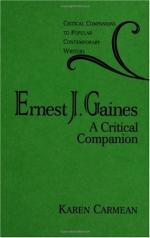|
This section contains 8,782 words (approx. 30 pages at 300 words per page) |

|
SOURCE: Doyle, Mary Ellen. “Ernest Gaines' Materials: Place, People, Author.” MELUS 15, no. 3 (fall 1988): 75-93.
In the following essay, Doyle contrasts the geographical, historical, and cultural implications of Gaines's fictional settings and characters with the conventions of modern Southern literature.
Southern Louisiana—Cajun Country—Pointe Coupée—New Roads—Oscar—River Lake Plantation—False River—pecan trees and live oaks—fields of sugar cane and cotton—bayous and “parishes”—“galleries” on plantation homes—cabins in “the quarters”: these make the “Place” of Ernest Gaines' fiction. Speakers of French, Cajun patois, or black English—black workers who cut cane and drive the mules that haul it—Cajun overseers who drive the cutters—black children who play in lanes, work like adults, and hide their toothache and hunger—old men who fish and hide their fears and resentful memories—young militants and the old folk who raised them, who both admire...
|
This section contains 8,782 words (approx. 30 pages at 300 words per page) |

|


